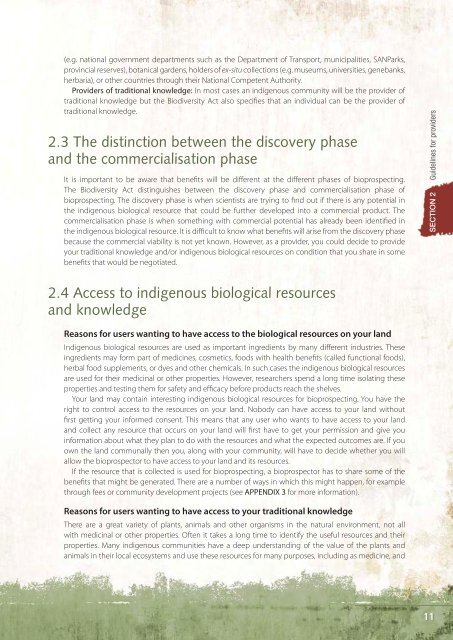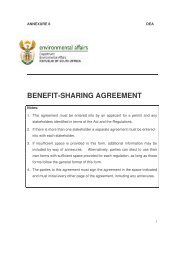South Africa's Bioprospecting, Access and Benefit-Sharing ...
South Africa's Bioprospecting, Access and Benefit-Sharing ...
South Africa's Bioprospecting, Access and Benefit-Sharing ...
Create successful ePaper yourself
Turn your PDF publications into a flip-book with our unique Google optimized e-Paper software.
(e.g. national government departments such as the Department of Transport, municipalities, SANParks,<br />
provincial reserves), botanical gardens, holders of ex-situ collections (e.g. museums, universities, genebanks,<br />
herbaria), or other countries through their National Competent Authority.<br />
Providers of traditional knowledge: In most cases an indigenous community will be the provider of<br />
traditional knowledge but the Biodiversity Act also specifies that an individual can be the provider of<br />
traditional knowledge.<br />
2.3 The distinction between the discovery phase<br />
<strong>and</strong> the commercialisation phase<br />
It is important to be aware that benefits will be different at the different phases of bioprospecting.<br />
The Biodiversity Act distinguishes between the discovery phase <strong>and</strong> commercialisation phase of<br />
bioprospecting. The discovery phase is when scientists are trying to find out if there is any potential in<br />
the indigenous biological resource that could be further developed into a commercial product. The<br />
commercialisation phase is when something with commercial potential has already been identified in<br />
the indigenous biological resource. It is difficult to know what benefits will arise from the discovery phase<br />
because the commercial viability is not yet known. However, as a provider, you could decide to provide<br />
your traditional knowledge <strong>and</strong>/or indigenous biological resources on condition that you share in some<br />
benefits that would be negotiated.<br />
Guidelines for providers<br />
SECTION 2<br />
2.4 <strong>Access</strong> to indigenous biological resources<br />
<strong>and</strong> knowledge<br />
Reasons for users wanting to have access to the biological resources on your l<strong>and</strong><br />
Indigenous biological resources are used as important ingredients by many different industries. These<br />
ingredients may form part of medicines, cosmetics, foods with health benefits (called functional foods),<br />
herbal food supplements, or dyes <strong>and</strong> other chemicals. In such cases the indigenous biological resources<br />
are used for their medicinal or other properties. However, researchers spend a long time isolating these<br />
properties <strong>and</strong> testing them for safety <strong>and</strong> efficacy before products reach the shelves.<br />
Your l<strong>and</strong> may contain interesting indigenous biological resources for bioprospecting. You have the<br />
right to control access to the resources on your l<strong>and</strong>. Nobody can have access to your l<strong>and</strong> without<br />
first getting your informed consent. This means that any user who wants to have access to your l<strong>and</strong><br />
<strong>and</strong> collect any resource that occurs on your l<strong>and</strong> will first have to get your permission <strong>and</strong> give you<br />
information about what they plan to do with the resources <strong>and</strong> what the expected outcomes are. If you<br />
own the l<strong>and</strong> communally then you, along with your community, will have to decide whether you will<br />
allow the bioprospector to have access to your l<strong>and</strong> <strong>and</strong> its resources.<br />
If the resource that is collected is used for bioprospecting, a bioprospector has to share some of the<br />
benefits that might be generated. There are a number of ways in which this might happen, for example<br />
through fees or community development projects (see APPENDIX 3 for more information).<br />
Reasons for users wanting to have access to your traditional knowledge<br />
There are a great variety of plants, animals <strong>and</strong> other organisms in the natural environment, not all<br />
with medicinal or other properties. Often it takes a long time to identify the useful resources <strong>and</strong> their<br />
properties. Many indigenous communities have a deep underst<strong>and</strong>ing of the value of the plants <strong>and</strong><br />
animals in their local ecosystems <strong>and</strong> use these resources for many purposes, including as medicine, <strong>and</strong><br />
11






![Innovation at UCT 2010 [Report] - Research Contracts & IP Services](https://img.yumpu.com/28928393/1/184x260/innovation-at-uct-2010-report-research-contracts-ip-services.jpg?quality=85)